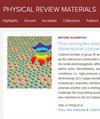Dual diffraction bands of heliconical liquid crystal gratings
IF 3.4
3区 材料科学
Q2 MATERIALS SCIENCE, MULTIDISCIPLINARY
引用次数: 0
Abstract
Gratings composed of cholesteric liquid crystals as an important optical element for emerging applications such as augmented and virtual reality and are renowned for their characteristic single reflective diffraction band. Heliconical liquid crystal is a newly discovered state where the constituent molecules self-organize into helical structures with a non-90° polar angle between the director and the helical axis. Here, we present a numerical study on the reflective diffraction of gratings made of heliconical liquid crystals. Remarkably, numerical results demonstrate that there exist two diffraction bands at the same diffraction angle, with one peak wavelength being twice the other. We show that the short-wavelength diffraction originates from the Pancharatnam-Berry phase acquired by the reflected light while the long-wavelength diffraction stems from the reflection of the slanted volume grating, and that the wavelengths of these two diffraction bands can be attributed to the first and second band gaps of the slanted volume grating as a one-dimensional photonic crystal. We further show that the polarization of the reflected diffraction light is circular, exhibiting the same handedness as the liquid crystal for the short-wavelength band, whereas it is perfectly linearly polarized along the grating direction for the long-wavelength band.

螺旋液晶光栅的双衍射带
由胆甾型液晶组成的光栅是增强现实和虚拟现实等新兴应用的重要光学元件,因其特有的单反射衍射带而闻名。螺旋液晶是一种新发现的液晶状态,其中的组成分子自组织成螺旋结构,导线与螺旋轴之间的极角不为 90°。在此,我们对螺旋液晶光栅的反射衍射进行了数值研究。值得注意的是,数值结果表明,在同一衍射角上存在两条衍射带,其中一条的峰值波长是另一条的两倍。我们证明,短波长衍射源于反射光获得的 Pancharatnam-Berry 相,而长波长衍射源于斜面体光栅的反射,这两个衍射带的波长可归因于斜面体光栅作为一维光子晶体的第一和第二带隙。我们进一步证明,反射衍射光的偏振是圆的,在短波长带表现出与液晶相同的手性,而在长波长带则沿光栅方向完全线性偏振。
本文章由计算机程序翻译,如有差异,请以英文原文为准。
求助全文
约1分钟内获得全文
求助全文
来源期刊

Physical Review Materials
Physics and Astronomy-Physics and Astronomy (miscellaneous)
CiteScore
5.80
自引率
5.90%
发文量
611
期刊介绍:
Physical Review Materials is a new broad-scope international journal for the multidisciplinary community engaged in research on materials. It is intended to fill a gap in the family of existing Physical Review journals that publish materials research. This field has grown rapidly in recent years and is increasingly being carried out in a way that transcends conventional subject boundaries. The journal was created to provide a common publication and reference source to the expanding community of physicists, materials scientists, chemists, engineers, and researchers in related disciplines that carry out high-quality original research in materials. It will share the same commitment to the high quality expected of all APS publications.
 求助内容:
求助内容: 应助结果提醒方式:
应助结果提醒方式:


